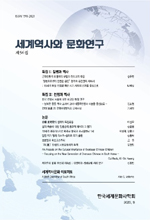추남설화에 투영된 6세기 고구려 정치의 편린
Fragments of 6th-Century Goguryeo Politics Reflected in the Tale of Chunam
- 한국세계문화사학회
- 세계역사와 문화연구
- 제72집
-
2024.095 - 42 (38 pages)
-
DOI : 10.32961/jwhc.2024.09.72.5
- 42

『삼국유사』 김유신전에 의하면, 고구려인 추남이 陰陽을 어긴 왕비와 관련 세력에게 억울한 죽임을 당한 후 원수를 갚고자 신라인 김유신으로 환생했다고 한다. 비현실적인 내용이다보니 추남설화는 황당한 이야기로만 치부될 수 있다. 그런데 조선시대 기록물인 『금오신화』, 『신증동국여지승람』, 『관서읍지』 등에서 평양의 명승지로 楸南墟 즉 추남의 옛 집터와 그 위치가 기록되어 있었다. 평양 지역 명승지로서 추남허의 존재는 평양 지역에서 추남이란 인물이 오랫동안 기억되고 전승되어 왔으며 추남을 평양에 살았던 실존 인물로 인식하였던 것과 무관하지 않다고 보았다. 추남설화 속에서 왕비가 음양을 어겨 고구려 국경의 역수를 유발했던 것처럼 6세기 중반 무렵 양원왕이 왕위를 계승하는 과정에서 승리한 왕비세력인 추군에게 반대편 왕비세력 세군이 대거 희생된 사건이 있었다. 공교롭게도 추남설화와 양원왕의 즉위 과정에서는 왕비와 왕비세력이 당대 고구려의 정치를 혼란하게 만들었다는 공통점이 있었다. 게다가 추남의 사망 시점은 늦어도 6세기 말을 넘을 수 없는데, 이는 양원왕의 즉위 시기와도 크게 차이가 나지 않았다. 여러 면에서 추남설화에 담긴 시대상은 6세기 중엽 고구려의 정치와 부합되며, 그래서 기왕의 고구려사 연구에서 제기되었던 6세기 무렵 왕비세력의 전횡을 살피는 사례로서 추남설화를 활용하였다.
According to the 『Samguk Yusa』, in the biography of Kim Yusin, a man from Goguryeo named Chunam was wrongfully killed by the queen and her associates for violating the principles of yin and yang. After his death, he was reincarnated as the Silla general Kim Yusin to seek revenge. While the story seems unrealistic, the tale of Chunam may be dismissed as mere fantasy. However, records from the Joseon Dynasty, such as 『Geumosinhwa』, 『Sinjeung Dongguk Yeoji Seungnam』, and 『Gwanseo Eupji』, note a famous site in Pyongyang called Chunamhuh, meaning the former site of Chunam’s residence, along with its location. The existence of Chunamhuh as a well-known landmark in the Pyongyang region suggests that Chunam had long been remembered and passed down through generations, implying that people recognized Chunam as a historical figure who once lived in Pyongyang. In the tale of Chunam, just as the queen’s violation of yin and yang caused disorder at the borders of Goguryeo, there was an incident in the mid-6th century during King Yangwon's succession, where the Chugunn faction, which supported the queen and emerged victorious, caused the significant loss of life among the opposing the Segun faction. Interestingly, both the tale of Chunam and King Yangwon’s succession process share the common theme of the queen and her faction disrupting Goguryeo’s political stability. Moreover, the timing of Chunam’s death could not have extended beyond the late 6th century, which aligns closely with King Yangwon’s ascension. In many respects, the political context reflected in the tale of Chunam corresponds with mid-6th century Goguryeo politics, particularly the dominance of the queen's faction. Thus, the tale of Chunam has been utilized as a case study to explore the abuses of power by the queen’s faction in the 6th century, a topic previously raised in research on Goguryeo history.
Ⅰ. 머리말
Ⅱ. 추남설화의 검토
Ⅲ. 추남의 자취와 사유
Ⅳ. 6세기 왕비세력의 전횡
Ⅴ. 맺음말
(0)
(0)